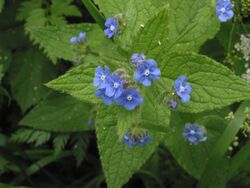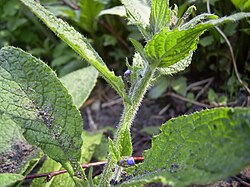Biology:Pentaglottis
| Green alkanet | |
|---|---|

| |
| Scientific classification | |
| Kingdom: | Plantae |
| Clade: | Tracheophytes |
| Clade: | Angiosperms |
| Clade: | Eudicots |
| Clade: | Asterids |
| Order: | Boraginales |
| Family: | Boraginaceae |
| Genus: | Pentaglottis Tausch |
| Species: | P. sempervirens
|
| Binomial name | |
| Pentaglottis sempervirens (L.) Tausch ex L.H.Bailey
| |
| Synonyms[1] | |
|
List
| |
Pentaglottis is a monotypic genus of flowering plants in the family Boraginaceae. It is represented by a single species, Pentaglottis sempervirens, commonly known as the green alkanet,[2] evergreen bugloss[3] or alkanet, and is a bristly, perennial plant native to southwestern Europe, in northwest Iberia and France.
Description
Pentaglottis sempervirens is a perennial, that has a deep tap root. It grows up to approximately 60–90 cm (23.6–35.4 in) tall with a roughly hairy stem. It has broadly ovate,[4] or pointed oval leaves and the lower leaves have leaf stalks. It can retain its green leaves through the winter. Green alkanet blooms in spring and early summer, between April and June,[4] or July. It has pink flower buds,[4] that open up to brilliant blue or bright blue flowers with a white centre, approximately 10 mm (0.4 in) wide. There are 5 sepals. It has clusters of flowers, but only one flowering at a time. Its stamens are hidden inside narrow flower-tubes which end in a white eye in the centre of a blue flower.[5]
The flowers are pollinated by bees and bumblebees, and the seed capsules can also be transported over some distances on passing animal fur or attached to clothing.[4]
Taxonomy

It is commonly known as evergreen-bugloss and green alkanet.[6]
The genus Pentaglottis was first published by Bohemian botanist Ignaz Friedrich Tausch (1793-1848), in Flora 12: 643 in 1829,[7] then the species Pentaglottis sempervirens was first published by American botanist Liberty Hyde Bailey (1858-1954) in Man. Cult. Pl., ed. 2: 837 in 1949.[1]
The genus name Pentaglottis is Greek, meaning "five tongues", and the species specific epithet of sempervirens is Latin, and means "always alive", or "evergreen".[8]
The word "alkanet" derives from Middle English, from Old Spanish alcaneta, diminutive of alcana, "henna", from Medieval Latin alchanna, from Arabic al-ḥinnā’, "henna" : al-: "the" + ḥinnā’, "henna". The common name of "alkanet" is also used for dyer's bugloss (Alkanna tinctoria) and common bugloss (Anchusa officinalis).
The genus Pentaglottis has 2 known synonyms, Carylopha Fisch. & Trautv. and Caryolopha Fisch. & Trautv.[7]
The genus and species are accepted by GRIN (United States Department of Agriculture and the Agricultural Research Service).[9]
Distribution

The native range of this genus is south western Europe. It is endemic to France, Portugal and Spain. It was introduced into the countries (and regions) of Australia (with the state of Tasmania) Belgium, Canada (within the province of British Columbia), Czechoslovakia, Great Britain, Ireland, Italy and the United States (within the states of California, Maine, Oregon and Washington).[7]
Green alkanet is an introduced species in the British Isles.[10]
Habitat
It is found in woods and in hedge-banks,[5] or in damp or shaded places and often close to some buildings. It likes alkaline soils and is considered a weed in some parts of the UK.[4]
-
Flower close-up
-
Stalk and flowers
-
Flower close-up
References
- ↑ 1.0 1.1 "Pentaglottis sempervirens (L.) Tausch ex L.H.Bailey | Plants of the World Online | Kew Science" (in en). https://powo.science.kew.org/taxon/urn:lsid:ipni.org:names:60457907-2.
- ↑ (xls) BSBI List 2007, Botanical Society of Britain and Ireland, https://bsbi.org/download/3542/, retrieved 2014-10-17
- ↑ "'Pentaglottis sempervirens'". Natural Resources Conservation Service PLANTS Database. USDA. https://plants.usda.gov/core/profile?symbol=PESE10.
- ↑ 4.0 4.1 4.2 4.3 4.4 "Green alkanet / RHS Gardening" (in en-gb). https://www.rhs.org.uk/weeds/green-alkanet.
- ↑ 5.0 5.1 Fitter, Richard; Fitter, Alastair (1978). The Wild Flowers of Britain and Europe (3 ed.). St James Place, London: Collins. ISBN 0-00-219069-9.
- ↑ Bennett, Masha (2003). Pulmonarias and the Borage Family. Timber Press. pp. 175-176. ISBN 0881925896.
- ↑ 7.0 7.1 7.2 "Pentaglottis Tausch | Plants of the World Online | Kew Science" (in en). https://powo.science.kew.org/taxon/urn:lsid:ipni.org:names:4741-1.
- ↑ Coombes, Allen (2012). The A to Z of Plant Names: A Quick Reference Guide to 4000 Garden Plants. Portland, Oregon: Timber Press. p. 28. ISBN 9781604691962.
- ↑ "Taxon: Pentaglottis sempervirens (L.) Tausch ex L.H. Bailey". https://npgsweb.ars-grin.gov/gringlobal/taxon/taxonomygenus?id=435073.
- ↑ http://www.nhm.ac.uk/fff-pcp/glob.pl?report=Flora&Flora.[FloraNo]=236800
External links
Wikidata ☰ {{{from}}} entry
 |




